Gamification in Healthcare Mobile App Development

Studies show that on an average, more than 100,000 new Android apps and more than 30,000 new iOS apps are released in app stores every month. But not every app is successful. To stand out in the competition, you have to offer something unique to your users, something fun! Today, functionality is everything, and a poor UX can guarantee the failure of your app.
Millennials and gen Z are the two most tech-savvy generations and if your app targets these groups, giving something exciting & challenging will help you persuade them to adopt your app & stick to it.
Gamification has proved to be one of the most powerful mobile app user engagement & retention strategies. And healthcare seems to be a perfect fit for it. Why? Because the ultimate goal of any mhealth app is to improve the health of its users and if such apps are amusing, we’re more likely to use it, isn’t it?
In this article, we’ll learn:
- What is Gamification & How does it work?
- Why Gamify mhealth Apps?
- Gamification Strategies in Healthcare Applications
- Important Points to Remember
What is Gamification & How Does it Work?
Gamification is the inclusion of gaming techniques, dynamics, and elements in non-gaming applications to solve problems, engage audiences and to make otherwise mundane tasks more fun and entertaining. This surely boosts user engagement, influences consumer behavior, contributes to the user’s experience and supports the user’s overall value creation. Classic gamification elements are leaderboards, badges, mystery boxes, competition.
The goal of game dynamics is to drive a user-desired behavior predictably. In order to do so we have to understand how humans behave. After all, as per “Gamification by Design” co-author Gabe Zichermann states: “Gamification is 75% Psychology and 25% Technology.”
The post-pandemic scenario has revolutionized the way the healthcare sector functions. It opened newer and unique avenues that involve remotely reaching out to patients via their smartphones. This further encouraged companies functioning in the healthcare sector to come up with innovative strategies to make the most of the innumerable hours spent by patients indoors. Leading gamified health apps engage the users with games concerning their health conditions and compensate through rewards. This technique makes diagnosis and treatment procedures more engaging by encouraging patients to participate in games, developing a sense of achievement upon winning some stage of the game, and increasing motivation levels to improve their overall health.
The gradual infusion of gamification techniques into the healthcare industry reveals that modern health app developers are way ahead of the stereotypical methods of healthcare application development.
Before we move forward, let’s take a quick look at some interesting market data:
- According to a report from Mordor Intelligence, the global gamification market was valued at USD 10.19 million in 2020 and expected to reach USD 38.42 million by 2026 and grow at a CAGR of 25.10% over the forecast period (2021 – 2026).
- Gaming is the most popular category in the Apple App Store accounting for nearly 25% of all mobile apps. This is two times more than the second highest category, Business (10.11%).
- The healthcare gamification market is estimated to grow at a CAGR of 36.2% to reach US$35,982.7 million in 2027 from US$ 3,072.5 million in 2019. This exponential growth shall be driven by technological advancements, rising use of smartphones, changing lifestyle, increasing digitalization, and growing focus on wellness.
- North America accounted for the largest share of the global healthcare gamification market and is expected to grow at a significant pace in the coming years, followed by Europe.
- The steep increase in the population of India and China, increasing adoption of smartphones, and growing innovation initiatives are factors contributing to the significant growth in the Asia Pacific region.
This holistic evaluation of the market shows innumerable optimistic opportunities for future investors looking for opportunities to add gamification to their mobile applications.
Why Gamify mHealth Applications?
You must consider incorporating gaming elements in your healthcare app, because it:
1. Boosts User Engagement:
Fun activities and fascinating rewards take the monotony out of everyday activities and excite users to actively participate in attaining their daily goals, thereby boosting overall user engagement. Games can be extremely captivating, especially when players level up every time they complete a challenge. With gamification, apps work in the same way. When users know that they can get something for using your app, they will spend more time on it.
2. Attracts New Customers:
Because gamification in health apps make such apps interesting and entertaining compared to its analog without gaming elements, it gives you an edge over your competitors and attracts new users. For example – when existing users share their achievements in popular social networks, it invites new customers.
3. Improves Customer Retention Rate:
It’s important for any business to retain its existing customers. And if your users are satisfied with your services, they will remain loyal to you. Gamification in fitness apps helps you make fitness and wellness entertaining and rewarding for your users.
4. Increases Visibility in Social Media:
Incorporating social sharing into branded games will boost your company’s social media presence. With social games, players commonly choose to share their results on social media, particularly by means of a leaderboard. Also, to get extra rewards, users also tend to follow your company’s page and share their experience of using your app on social media. Such behavior inherently creates your brand’s awareness and expands your brand’s audience by extending the reach of your brand identity to entirely new consumers.
5. Improves User’s Overall Health:
Being in the healthcare sector, your ultimate goal is to improve the health of people through your services. Gamification in healthcare helps you achieve this by first attracting customers, engaging them, and then turning them into addicts who keep coming back for more. And because these games are directly associated with their health, they don’t realise but such behaviour positively impacts their medical conditions. This is hence a win-win for both the parties.
Gamification Strategies in Healthcare Applications:
Well-thought and dedicatedly constructed strategies determine the success of a mhealth app. Let us look at the different strategies that you can use for your gamified healthcare application development:
1. Storytelling:
Storytelling has its root in our childhood. Gamified health apps use this power of storytelling to connect with users and grab their attention. Zombies, Run! is an ultra-immersive gamified running app, where every user acts as the hero of a series of missions, during which they run and listen to various audio narrations to uncover a zombie adventure story. And to keep loyal users interested, the company continues to record new seasons of this never-ending story. Such apps make fitness adaptive and entertaining.
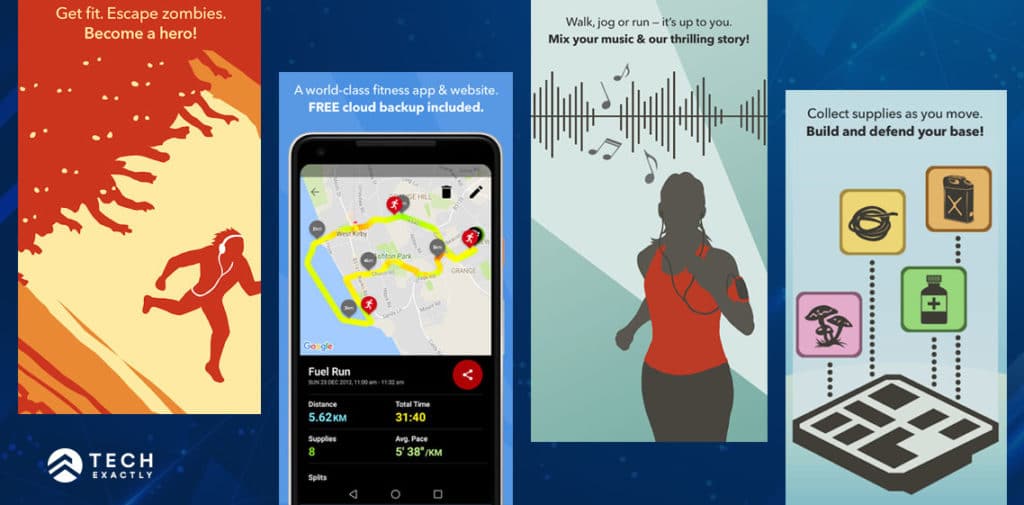
2. Challenges:
Humans like challenges and they like to come out of it as winners. This approach spurs competition and enhances performance of users by allowing them to challenge friends, family or anybody from the community. For instance- Escape from Diab, Studio, Challenges – Compete, Get Fit.
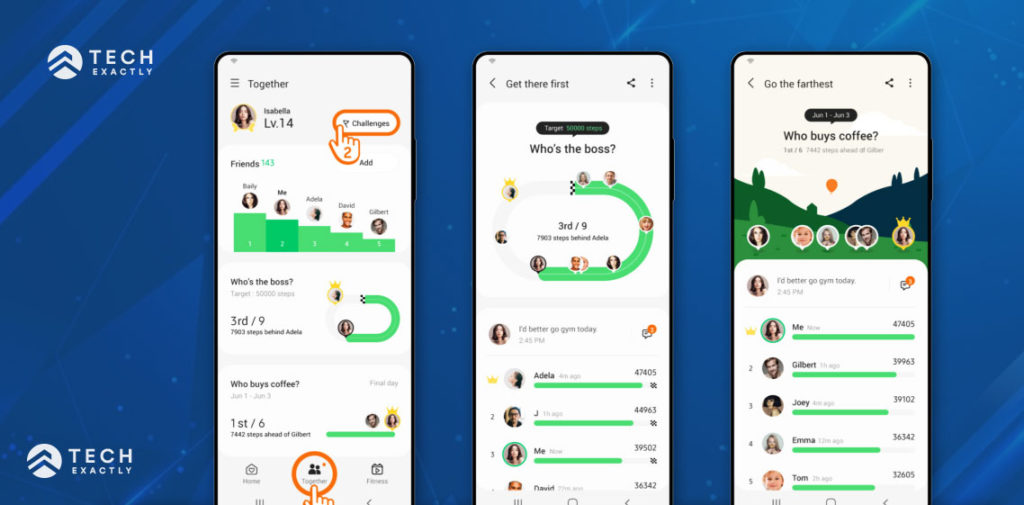
3. Levels:
Levels are various parts of a game. With each level up, the complexity of the game increases, challenging the player with new and exciting actions. This shoots the curiosity levels of players, encouraging them to get further.
4. Progress Display:
These graphs or charts show a player’s performance in comparison with their previous results and track the progress made towards the goal. With such records, an individual is able to evaluate himself better and gets motivated to do more. For instance, gamified fitness app, Fitbit helps users to track their steps, calories, etc.
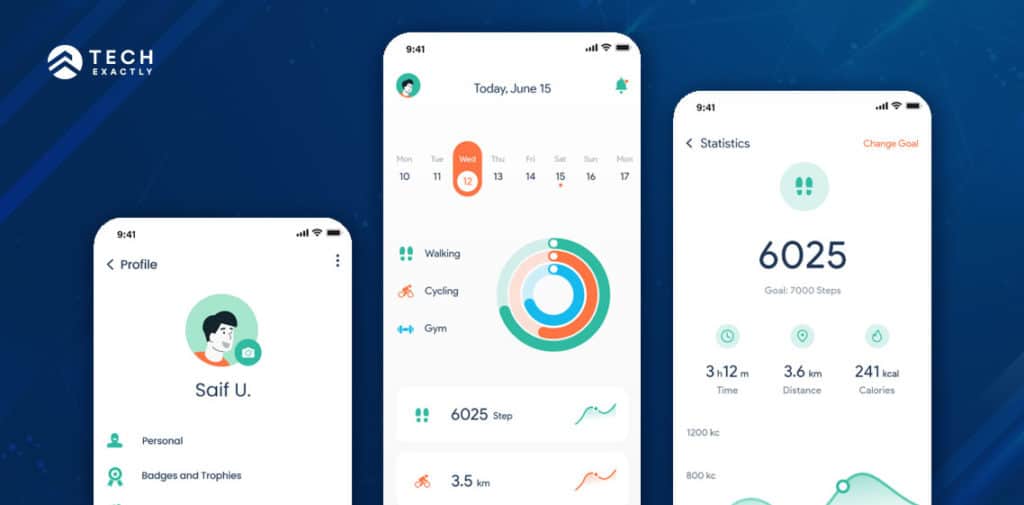
5. Leader Boards:
Many times, people feel more interested and tempted when they compare their performance with others. It’s human nature to give it their best shot to win the race. Leaderboards give you a clear picture of the ranking of various participants. Unlike progress displays, leaderboards show a user’s performance in relation to the performance of other players, hence motivating the user to try harder. And the biggest joy is in sharing these wins on social media and enjoying the attention just like in the game, Catch The Sperm, which focuses on prevention of HIV.
6. Awards:
Digital badges, medals, and trophies are visual presentations of users achievements after they have, say, reached their weekly or monthly goal, completed their first set of exercise routine, or walked a certain number of steps in a day, etc. People tend to complete actions if they know their efforts will be recognised which ultimately engages users and brings additional revenue to you. FitBit, Apple’s Activity app are popular gamified workout apps that have used this strategy to build a huge customer base.
Pro Tip: Remind users to share everytime they receive an award. This will help you acquire new users.
7. Rewards:
Rewards drive people to try and complete difficult tasks. Accomplishing personal targets, participating in competitions or quizzes, sharing posts with friends or inviting them to join the app are some instances when you can choose to reward your users. There can be different forms of rewards like points or in-app currency which can be exchanged for digital or physical goods (like frequent flier miles in Airlines apps, or cash rewards by credit card companies) or to make special purchases in the app to stay ahead in a game, cash prizes in e-wallets of the app, coupons for discount on medicine purchase or lab tests, free 1 month subscription to a paid health app, etc. Example – Gamified fitness apps like HealthyWage, Sweatcoin, MangoHealth.
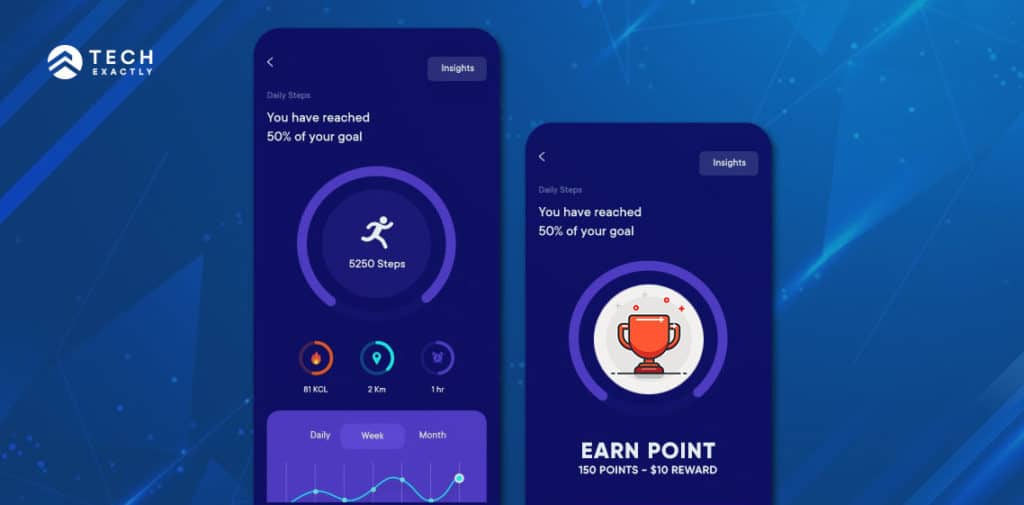
8. Punishments:
This is the reverse of gratification, making this concept unique and uncommon. This approach penalises users for not achieving their goals. CARROT, for example, is designed for workouts and calorie counting that uses hilarious chubby avatars for users to choose from to represent themselves and amusing animations of CARROT’s punishments when users gain weight instead of losing it. And many users actually appreciate this touch of cruel humour.
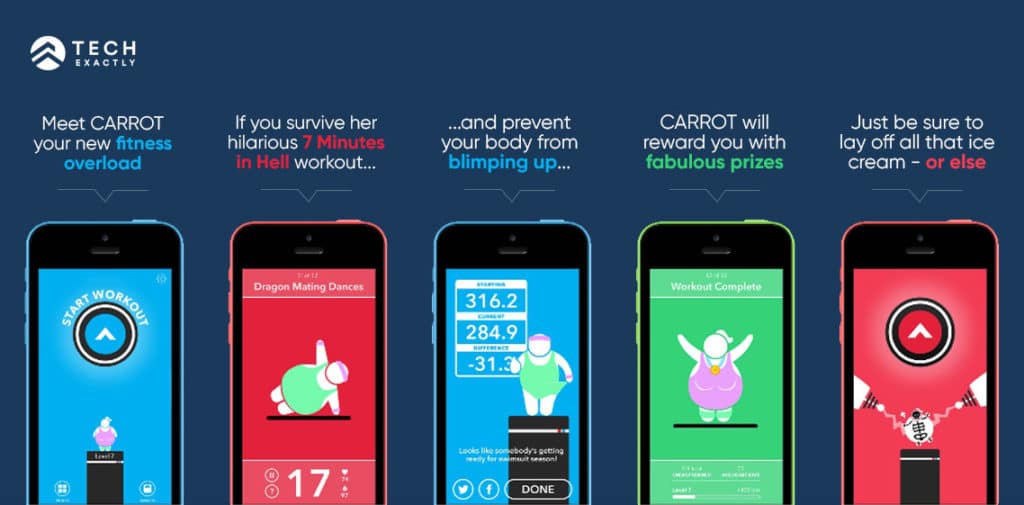
9. Avatars:
Avatars are virtual representatives of your users. Having a visual manifestation plays a very critical role in enhancing user’s engagement as it helps them satisfy their need for self-expression and connect with the character intrinsically. For example Carrot Fit, Fitness Kids, FitRPG.
10. Social Interaction:
Most fitness apps incentivize users for sharing their activities on social media. This could be in the form of unlocking new levels, getting extra coins or badges, etc. Moreover, people are also inclined to invite or challenge their friends and family during their fitness journey, which guarantees brand promotion and new users to your app.
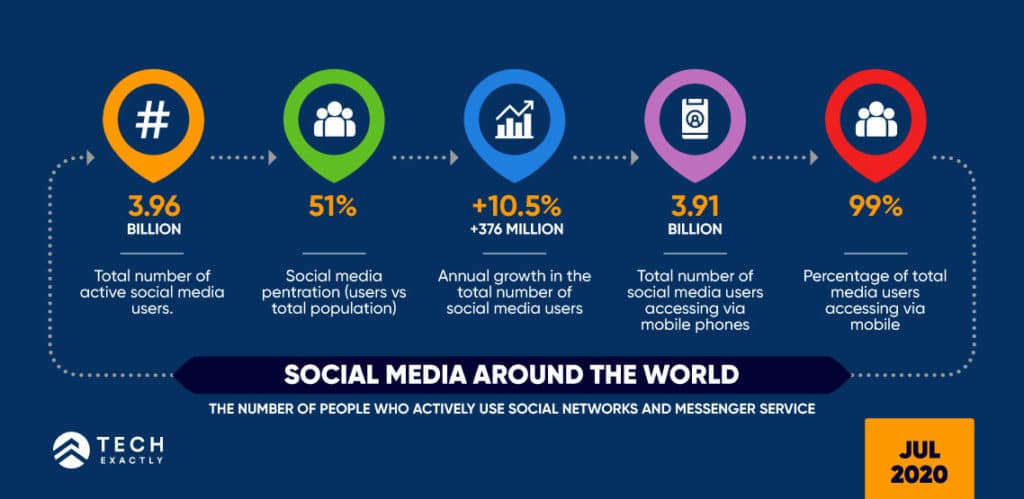
Important Points to Remember:
Before you set out to incorporate gamification attributes in your healthcare app, it is essential to keep the following points in mind for a progressive approach towards your business idea:
1. Identify the Problems you want to Solve:
Start with setting business objectives that you want to attain. You must identify the issues that you want to solve to provide maximum value to your users, look through the prism of purpose for achieving your future goals and defining your app gamification strategy for development. Layout a well thought-out app development plan including the gaming elements that suits your app the best.
2. Define your Users and Understand their Needs:
Identify your target users and incorporate playful elements according to their needs and preferences. Your product should be smart to offer innovative solutions and elements to meet your target’s needs and requirements. Expectations can be identified by generating customer feedback and market surveys. This will help you make your app user-centric and increase the probability of its success.
3. Build Sharing Loops:
To foster growth in your business and revenue, you must allow users to share & flaunt their accomplishments on popular social networks right from your app which in turn will help you acquire new customers. Also, remind users to share when they receive an award. This is one of the most effective ways of effortless app marketing and promotion.
4. Focus on Simplicity:
Do not make your gamification elements too complex and complicated for users as it hinders user experience. The rules of the games must be easy to understand and winning should be possible to achieve your dual purpose of engagement & retention.
5. Prioritize Entertainment Value:
The more playful and enjoyable your app is, the more happy your customers are. For successful app gamification, you must generate curiosity among your users by providing something new, challenging and unpredictable throughout the game.
6. Implement a Quick Reward System:
Users are motivated when they receive acknowledgment in the form of rewards at quick intervals. Small tokens of rewards at achieving milestones work better than providing a big reward after several stages in the game. This helps in keeping the user engagement intact and safeguards their interests.
7. Pay Close Attention to User Feedback:
All leading apps are ranked based on the ratings and feedback received from the customer. Higher the rating, higher are your chances to get a good position in the app store and hence get more number of app installs. So, it is advisable to hear what your users want and keep updating your app to incorporate latest technology & features and user’s needs & demands.
The Game has Just Begun!!
The bottom line is: ‘Normal is Boring’ and bored customers are detrimental to any business. Gamification of healthcare apps has set a bar for improved user-experience through various unique attributes and conceptual strategies. Health apps prioritize user engagement and encourage the users to face step-by-step challenges by not only treating their health issues, but also motivating them to emerge as winners at the end of the games.
Leading pharmaceutical companies are investing in mHealth apps to improve the health of the users via gamification, which is proving to be an effective tool with every passing day. When apps include elements of fun, users are more likely to use it. Taking things further, the addition of incentives, both big and small, boosts user engagement.
Tech Exactly is a healthcare mobile app development company, who aims to equip you with a feature-rich mobile healthcare application that is customized to suit the requirements of your business. We provide a dedicated team of engineers who have the expertise to understand your requirements and build a cost-effective gamified solution that will help you in standing apart from the crowd and transform your dreams into reality.
Your search for a tech partner ends with us. Speak to our consultants today to know more about our services. Call or chat online today!
